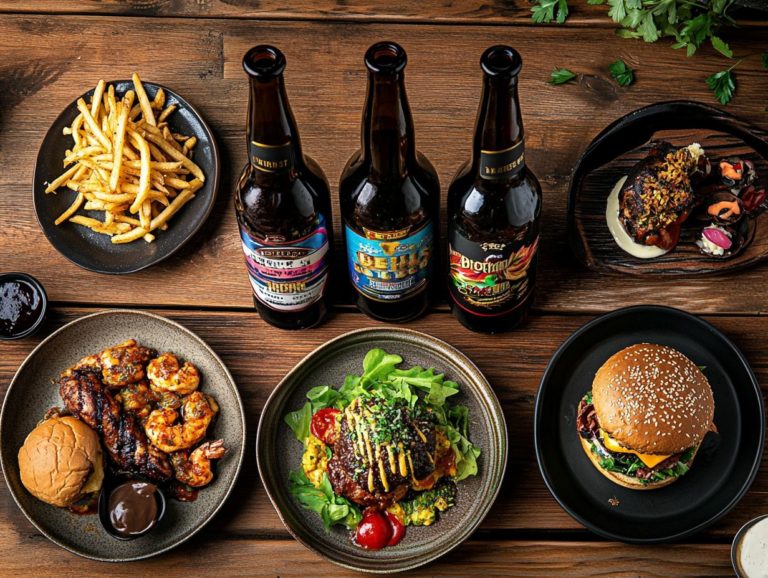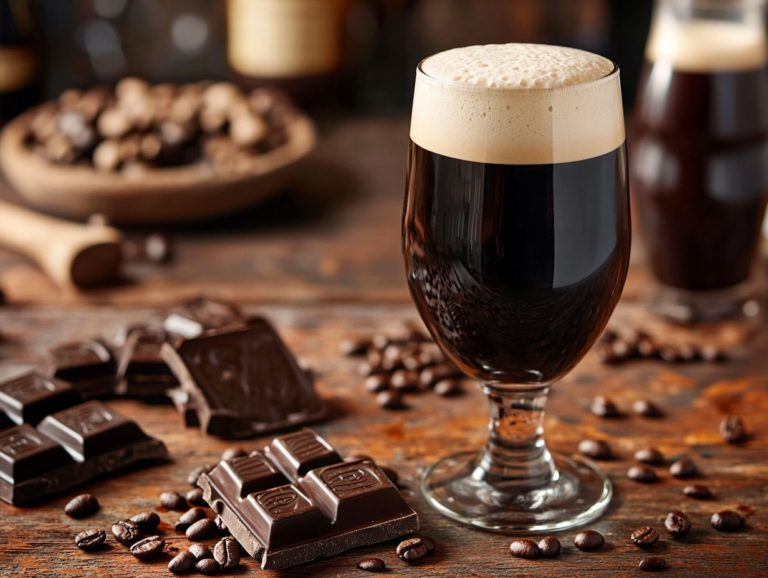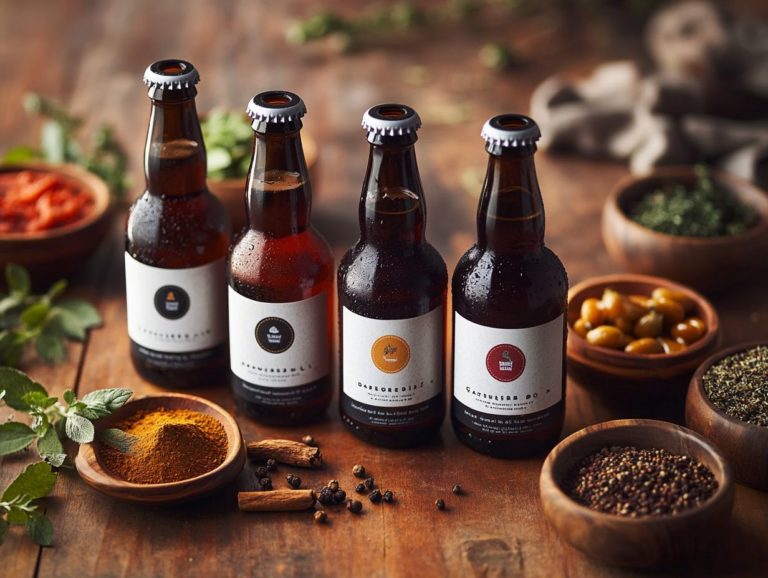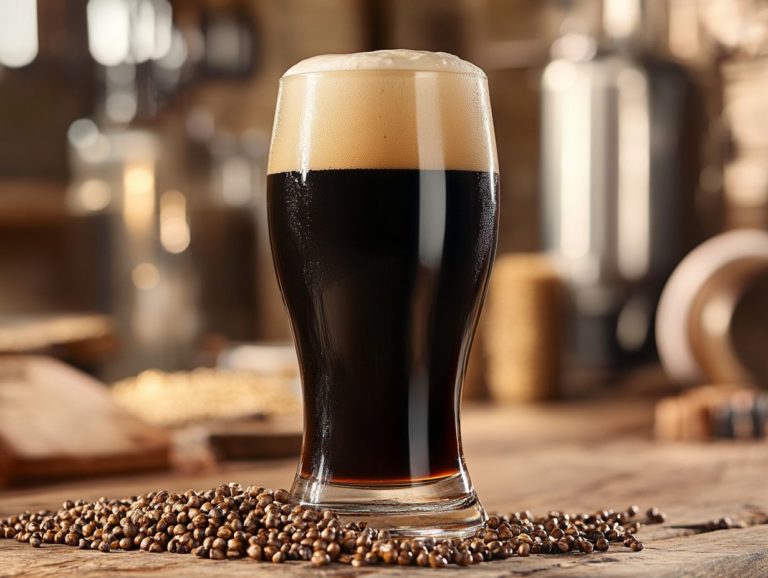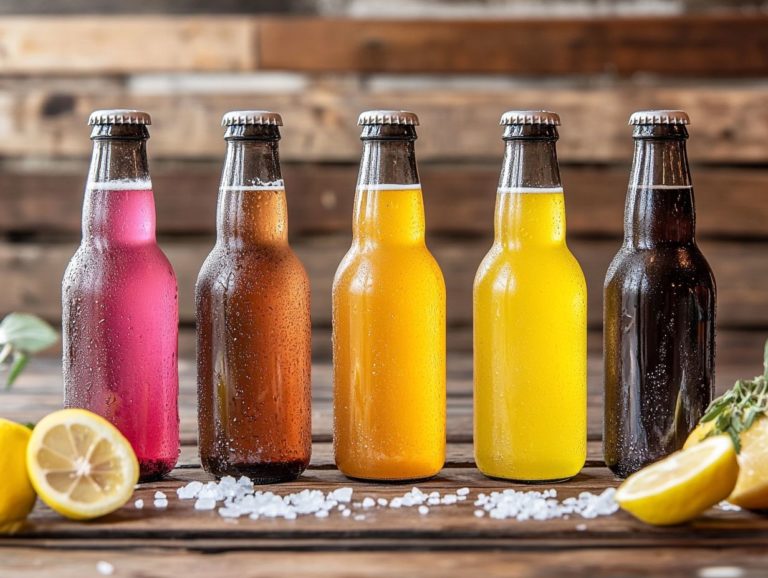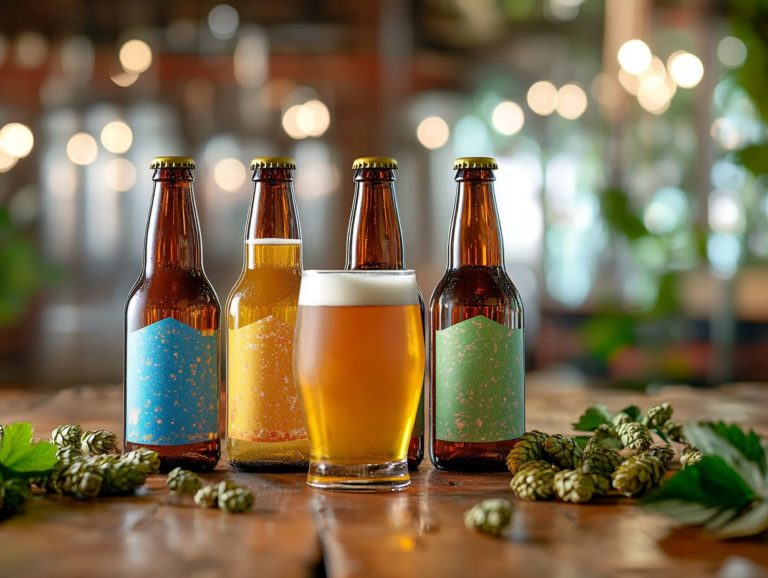Exploring the Flavor Profiles of Belgian Ales
Belgian ales embody the pinnacle of brewing artistry, renowned for their rich flavors and diverse styles that have enchanted beer enthusiasts globally.
With origins that trace back centuries, these exceptional brews weave a captivating tale of tradition and innovation. From the Trappist ales, or beers made by monks in Trappist monasteries, to the refreshing witbiers and intricate lambics, the variety is nothing short of endless. The rich history of Belgian beer is also connected to its diverse culture, influencing the production of not just beer but also culinary delights like Belgian chocolate, waffles, and French fries.
Dive into the rich history and explore the many exciting styles of Belgian ales! Each invites you to uncover your next favorite brew.
Contents
- Key Takeaways:
- What Are Belgian Ales?
- History of Belgian Ales
- Origins of Belgian Ales
- Evolution of Belgian Ales
- Types of Belgian Ales
- Saison
- Lambic
- Belgian Dubbel
- Belgian Tripel
- Belgian Quadrupel
- Flavor Profiles of Belgian Ales
- Exploring Belgian Ales
- Fruity and Tart
- Earthy and Funky
- Food Pairings with Belgian Ales
- Frequently Asked Questions
- What are Belgian Ales and why are their flavor profiles unique?
- What are some common flavors found in Belgian Ales?
- How do different brewing methods affect the flavor profiles of Belgian Ales?
- What food pairings work well with Belgian Ales?
- How should Belgian Ales be served to fully appreciate their flavor profiles?
- Are there different styles of Belgian Ales and how do they differ in flavor profiles?
Key Takeaways:
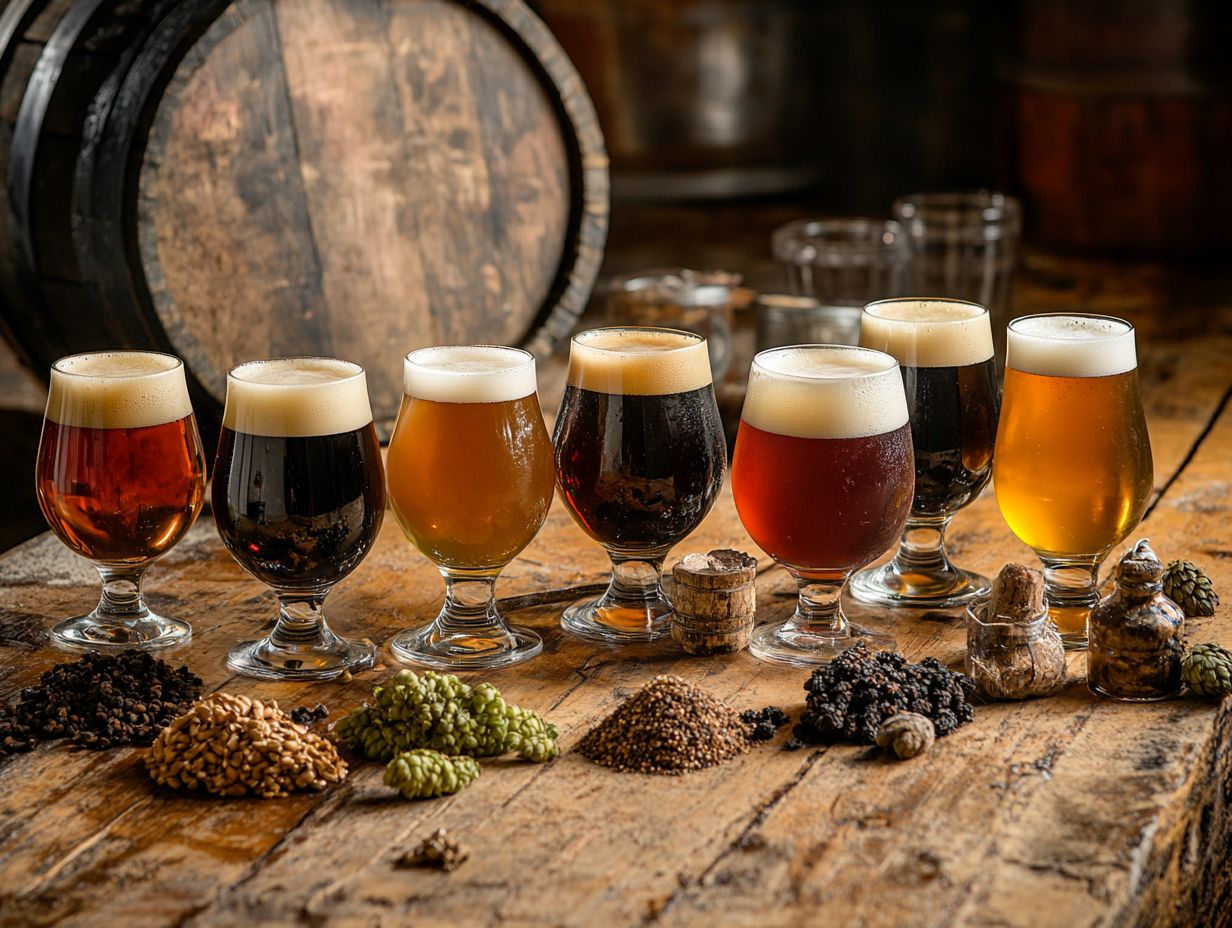
- Belgian ales are a diverse and complex style of beer with a rich history dating back centuries.
- There are many different types of Belgian ales, each with its own unique flavor profile, from sweet and malty to spicy and tart.
- These flavorful beers pair well with a variety of foods, including cheeses, meats, seafood, and desserts.
What Are Belgian Ales?
Belgian ales embody a diverse and rich category of beer that originates from Belgium, celebrated for their complex flavors and distinctive brewing techniques. As you explore these remarkable brews, you’ll encounter a variety of styles, from Trappist ales to abbey ales, farmhouse ales, and saison.
Each offers a unique taste profile that delights beer enthusiasts around the world. Imagine savoring the sweet and malty characteristics of a Belgian Dubbel. Or enjoying the fruity and spicy notes of a Saison. Each sip reflects Belgium’s storied brewing heritage and the meticulous use of high-quality ingredients like malt, hops, and yeast.
Perhaps you’ll even indulge in the luxurious flavors of a Belgian Quadrupel, known for its higher alcohol content and richness. Belgian ales typically have a higher alcohol content, ensuring they stand out prominently in the craft beer scene.
History of Belgian Ales
The history of Belgian ales is a captivating journey that intertwines seamlessly with Belgium’s rich culture, tracing back centuries to when local monasteries began brewing beer as a means of sustenance for themselves and their communities.
The Trappist Order was instrumental in this evolution. Monks diligently adhered to traditional brewing methods, crafting unique beer styles that have become emblematic of Belgium. Their unwavering dedication to quality and craftsmanship laid the foundation for the remarkable variety of Belgian ales you savor today, from the delightful fruity notes of Lambics to the deep, malty flavors found in complex Quadrupels.
As Belgian brewing garnered international acclaim, it not only transformed local consumption patterns but also captured the attention of craft beer enthusiasts across the globe, firmly establishing Belgium as a premier beer destination. Modern breweries like Brasserie Dupont and Duvel Moortgat continue to innovate while honoring traditional methods, making Belgium a true paradise for beer lovers.
Origins of Belgian Ales
The origins of Belgian ales can be traced back to the early medieval period, when local breweries began to emerge, often linked to monasteries where Trappist (a type of beer brewed by monks) monks honed their brewing skills for food and drink. These monks were pioneers in refining the styles we now recognize as abbey ales, utilizing traditional methods that prioritized quality ingredients and distinctive fermentation processes.
As these brewing practices evolved, regional variations began to surface, reflecting local tastes and ingredients. This ultimately enriched the diverse tapestry of beer styles celebrated in Belgium today.
The monastic brewing tradition not only provided a means of livelihood but also established a cultural framework that fostered innovation. Each monastery nurtured its unique recipes and techniques, giving rise to styles like Dubbel and Tripel, known for their distinct flavor profiles and higher alcohol content.
Monks were inclined to experiment with various spices and fruits. This experimentation led to the creation of celebrated Belgian styles such as Lambic and Saison. This communal approach to brewing facilitated knowledge sharing, fostering a sense of camaraderie and driving the development of local specialties that continue to enchant beer enthusiasts around the globe. Today, the influence of these traditional brews can be seen in modern hybrid styles like Belgian IPAs and barrel-aged variations, which blend old-world techniques with contemporary innovation.
Evolution of Belgian Ales
The evolution of Belgian ales presents a fascinating journey of brewing techniques and styles that have gracefully adapted over time. They have been shaped both by regional traditions and the invigorating influence of craft beer movements.
You ll find that from the traditional Trappist ales, meticulously crafted by monks and known for their higher alcohol content and intricate fermentation profiles, to the bold and innovative approaches of today s breweries, Belgian ales have consistently pushed the boundaries of flavor and brewing artistry.
This transformation shows not only the rich history of Belgian brewing but also the expanding global appreciation for unique, high-quality beers. The incorporation of local ingredients like Belgian chocolate and spices has further enhanced the complexity and allure of these brews.
In recent years, the craft beer movement has breathed new life into this landscape. It has encouraged brewers to experiment and embrace diversity. As a result, modern interpretations of Belgian styles now often feature unconventional ingredients and techniques, offering a broad spectrum of flavor profiles that range from fruity and spicy to sour and earthy.
Daring creativity shines through in the emergence of hybrid styles, such as Belgian IPAs and barrel-aged variations, which marry the robust character of Belgian yeast with the assertiveness of hops.
The fusion of traditional methods with contemporary innovation enriches your palate while rekindling interest in the cultural heritage of Belgian brewing. It s a celebration of the profound impact this tradition has had on the global craft beer scene, inviting you to dive into every delightful sip.
Types of Belgian Ales
Belgian ales present a fascinating spectrum of styles, each brimming with unique characteristics that embody the rich brewing traditions of Belgium. Picture yourself savoring the esteemed Trappist ales, like Westmalle and Chimay, alongside the refreshing Witbier and the celebrated Saison.
Each of these beers offers a delightful balance of flavors that appeals to a variety of tastes. For example, the Belgian Dubbel is renowned for its malt-forward sweetness and notes of dark fruit, while the Belgian Tripel dazzles with its bright golden hue and higher alcohol content, often showcasing fruity and spicy esters derived from fermentation.
The introduction of other styles such as Lambic and Gueuze, along with sour varieties like Flanders red and Flanders brown, further highlights the incredible diversity found within Belgian ales. This diversity makes them a truly captivating pursuit for beer enthusiasts and connoisseurs alike. Cheers to your next beer adventure!
Trappist Ales
Trappist ales represent a truly exceptional category of Belgian beer, brewed within the sacred walls of Trappist monasteries. This practice, steeped in centuries-old traditions, is upheld by monks who dedicate their skills and passion to crafting outstanding brews. You ll find that these ales often boast a higher alcohol by volume (ABV) and intricate flavor profiles, thanks to meticulous brewing techniques and the use of high-quality local ingredients.
Noteworthy examples include Westvleteren, Rochefort, Westmalle, Chimay, and Orval, each offering a remarkable tasting experience that reflects the rich heritage of Belgian brewing. In every bottle, you can sense the monks unwavering commitment to excellence and tradition, making these ales a genuine treasure in the realm of craft beer.
What truly sets these beers apart is their adherence to time-honored methods, such as spontaneous fermentation a brewing method that relies on wild yeast from the environment and the employment of distinctive yeast strains, all infused with the monks’ spiritual devotion to their craft. Each sip you take reveals a tapestry of flavors, from fruity esters and earthy spices to sumptuous caramel and dark fruit notes, transforming each sip into a delightful journey of flavors.
The significance of the Trappist Order goes beyond just brewing; it encapsulates a philosophy of sustainability and community, underscoring the essential nature of preserving their brewing legacies. Their deep-rooted connection to their environment and faith elevates Trappist ales, transforming each selection into not merely a beverage, but a vessel for storytelling, rich with history and tradition.
Witbier
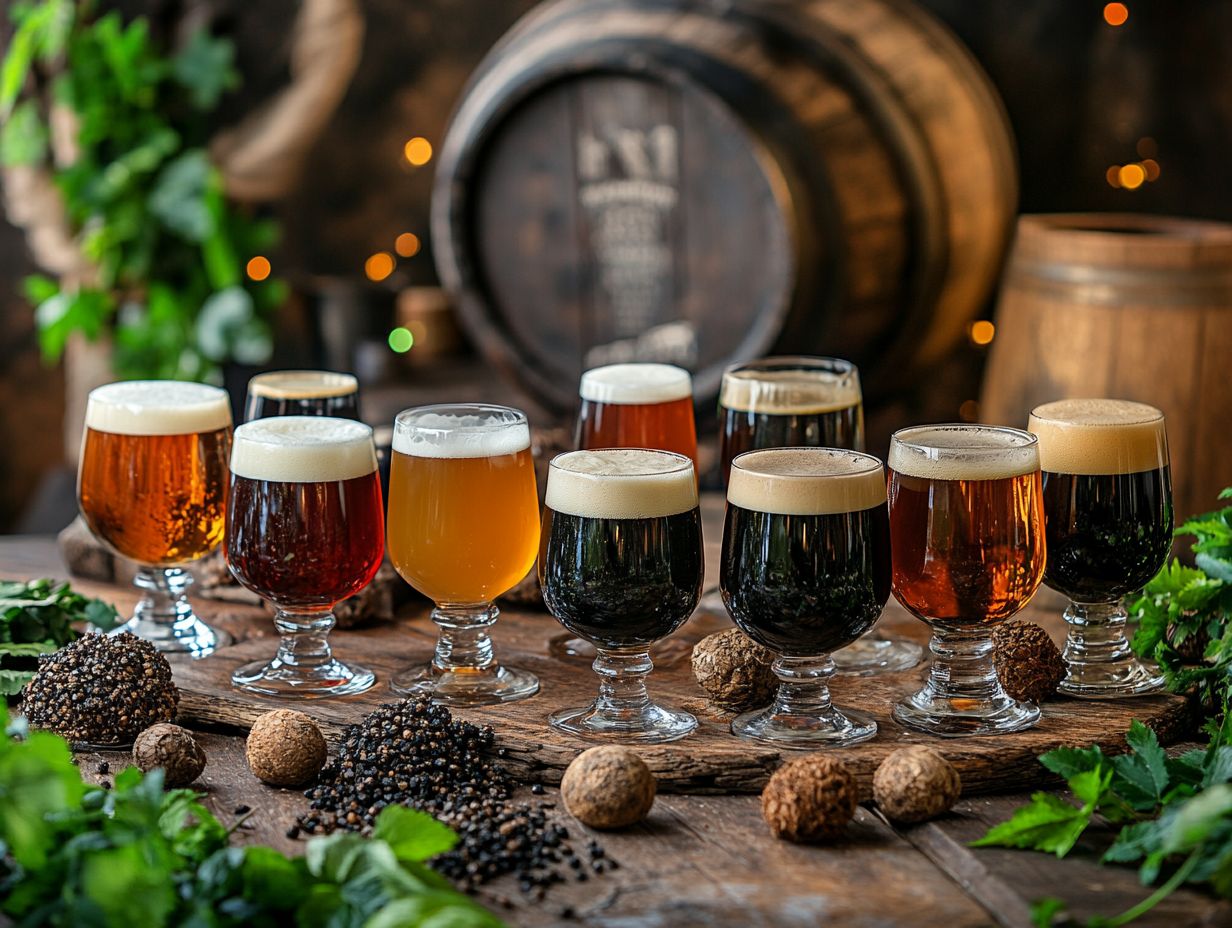
Witbier, often known as Belgian white beer, is your go-to refreshing and spiced ale that s brewed with a generous amount of unmalted wheat, resulting in that enticing hazy appearance and a delightfully smooth mouthfeel. With its roots in Belgium, this style beautifully blends flavors from coriander and citrus peel, creating an aromatic profile that makes it an ideal companion for warm weather.
Local breweries have embraced Witbier, putting their own spin on it with regional ingredients and unique brewing techniques. This means you can savor a delightful beverage that suits both a sunny terrace and a cozy pub ambiance.
The unique brewing process typically involves a careful combination of barley and wheat malts, along with adjuncts like orange peel and spices added during fermentation, all contributing to its complex flavor profile. Some variations may also include citrus elements, enhancing the beer’s refreshing qualities.
Picture yourself enjoying this refreshing beer served in a tall, elegant glass designed to showcase its foamy head, inviting you to take in its fragrant aromas fully.
Pair Witbier with your favorite dishes, and watch the flavors elevate your meal! Light seafood dishes, French fries, or fresh salads complement it beautifully, enhancing the overall experience. As craft breweries continue to explore innovative twists, the classic Witbier remains a captivating choice for Belgian beer enthusiasts, effortlessly bridging the gap between cherished tradition and modern tastes.
Saison
Saison is a unique Belgian ale from the charming farmhouses of Wallonia. Traditionally crafted in winter, it is meant for enjoyment during the summer harvest season.
This style has unique flavors that often delight the palate with fruity esters, spicy phenols, and a dry finish.
As a quintessential farmhouse ale, its flavors represent the local terroir, the influence of the local environment on the beer. The fermentation process frequently involves wild yeast strains, adding to its character.
Today, Saison enjoys international acclaim. Craft breweries worldwide experiment with this classic style, sometimes blending it with American IPA for innovative takes.
Historically, this farmhouse ale quenched the thirst of seasonal workers. Its rustic roots shine through in its unrefined appearance.
Many brewers embrace traditional techniques, incorporating locally sourced ingredients. This results in significant variability in taste and aroma.
Some Saisons burst with bold citrusy hop notes, while others offer earthy and herbal qualities, showcasing a remarkable range of possible flavors.
This adaptability highlights the brewer’s skill and connects you to the agricultural heritage from which it emerged. Each sip takes you on a delightful journey back to the countryside. Don t miss out on this experience!
Lambic
Lambic is a traditional Belgian beer style that captures the essence of spontaneous fermentation. It utilizes the wild yeast and bacteria that float in the air.
This process imparts distinctive flavors uniquely tied to its region. Unlike most beers brewed with cultivated yeast, Lambics age in wooden barrels.
This aging allows a complex interplay of flavors to evolve over time, creating an experience that is as rich as it is nuanced.
Among the varieties, Gueuze stands out as a blend of young and old Lambics, offering a tart and effervescent delight.
The aging process can extend for months or even years, adding depth and character that beckons to be savored.
In Belgian culture, Lambic beers hold a significant place. They are often enjoyed at social gatherings and celebrated for their intricate flavors.
The combination of spontaneous fermentation and barrel aging highlights the brewer s expertise and embodies the spirit of regional craftsmanship.
Each sip serves as a testament to the rich Belgian brewing heritage, inviting you to appreciate the artistry and tradition that go into every glass.
Belgian Dubbel
Belgian Dubbel is a rich ale with roots in monastic brewing traditions. You will notice its deep amber to reddish-brown color and malt-forward profile.
Its delightful notes include caramel, dark fruit, and a hint of subtle spiciness. This style is crafted using traditional methods and high-quality ingredients that enhance its sweetness and complexity.
With moderate alcohol content, it balances beautifully with various foods, making it a cherished choice for beer enthusiasts.
The brewing process typically involves a carefully selected combination of Belgian malts, contributing to the beer’s signature sweetness and rich mouthfeel.
Fermentation often uses special yeast strains that impart distinctive fruity and spicy esters, resulting in layers of flavor that truly delight the palate.
Regarding food pairings, this exceptional ale complements hearty dishes like beef stew or coq au vin exceptionally well.
It also pairs beautifully with rich cheeses such as Aged Gouda and blue cheese, elevating your dining experience.
Its versatile nature invites adventurous pairings, establishing it as a staple for both casual get-togethers and more formal gatherings.
Belgian Tripel
Belgian Tripel is an illustrious ale that captures the hearts of beer aficionados with its radiant golden hue and complex flavor profile. You ll find a delightful balance of fruity esters, spicy phenols, and a warming alcohol presence, usually showcasing a higher ABV that adds to its allure.
This style, steeped in Belgian Brewing Tradition, emerges from a meticulous fermentation process that enhances its aromatic qualities, crafting a layered tasting experience.
With its effervescent carbonation and dry finish, Belgian Tripel offers both refreshment and satisfaction, making it an impressive companion for a variety of dishes:
- Succulent seafood
- Indulgent cheeses
When brewing Belgian Tripel, brewers carefully select yeast that ferments efficiently, resulting in a dry finish and elevated ABV, often reaching up to 9%. You’ll discover characteristic flavor notes that include a delightful interplay of floral hops and subtle citrus hints, beautifully complemented by a gentle malt sweetness, resulting in an enticing and harmonious blend.
To truly savor the nuances of this exceptional ale, consider pairing it with dishes like:
- Herb-roasted chicken
- Creamy pasta
- Spicy cuisine
Such pairings can elevate your tasting experience, inviting you to explore the depth and complexity that Belgian Tripel has to offer.
Belgian Quadrupel
Belgian Quadrupel is a style that beckons you with its intense flavor and impressive ABV, often surpassing 10%, solidifying its status as one of Belgium s strongest ales. You’ll notice its dark, rich color and a complex flavor profile that beautifully combines notes of caramel, dark fruit, and subtle sweetness, all thanks to the meticulous selection of malt and fermentation techniques.
Renowned for its full-bodied character and warming qualities, the Quadrupel presents a delightful sipping experience best savored in moderation. It pairs wonderfully with:
- Rich, hearty dishes
- Luxurious doughnut desserts
This strong ale is a testament to the depth and complexity of Belgian brewing.
The brewing process features a unique mash that fosters deep, caramelized sugars, contributing to that signature sweetness. As fermentation unfolds, Belgian yeast strains add fruity esters and spicy phenols, further enriching the already intricate taste.
You ll find that it pairs exquisitely with traditional Belgian cuisine, such as:
- Stews
- Roasted meats
- Decadent chocolate desserts
The Quadrupel can even elevate a cheese flight, especially those robust flavors found in blue cheese and aged Gouda.
Its multi-layered profile also makes it a prime candidate for aging, allowing those delightful flavors to mature and evolve over time something every beer enthusiast will surely appreciate.
Flavor Profiles of Belgian Ales
The flavor profiles of Belgian ales are as diverse as the styles themselves, presenting an extraordinary range of taste experiences that exemplify the artistry of Belgian brewing. Many of these ales are bottle-conditioned, adding further complexity. You ll often find a rich maltiness serving as the foundation, imparting a delightful sweetness and depth.
The incorporation of hops introduces an intriguing spectrum of bitterness and aromatic qualities, adding layers to the experience. Variants like Belgian IPA feature more pronounced hop profiles.
The fermentation process is vital, as it unleashes unique esters and phenols that yield fruity, spicy, or earthy notes, weaving an intricate tapestry of flavors that can be both refreshing and complex. Whether you lean toward the bright citrus notes typical of some Saisons or the dark fruit characteristics found in a Quadrupel, there s no doubt that Belgian ales offer a delightful option for every discerning palate.
Other styles like Bi re de Garde and Flanders Red and Brown ales also contribute to the rich tapestry of flavors.
In conclusion, the diverse range of Belgian ales from the bright and effervescent Tripel to the deep and complex Quadrupel invites exploration. Don t miss the chance to discover the bold flavors and unique pairings that these remarkable brews have to offer.
Exploring Belgian Ales
Sweet and Malty
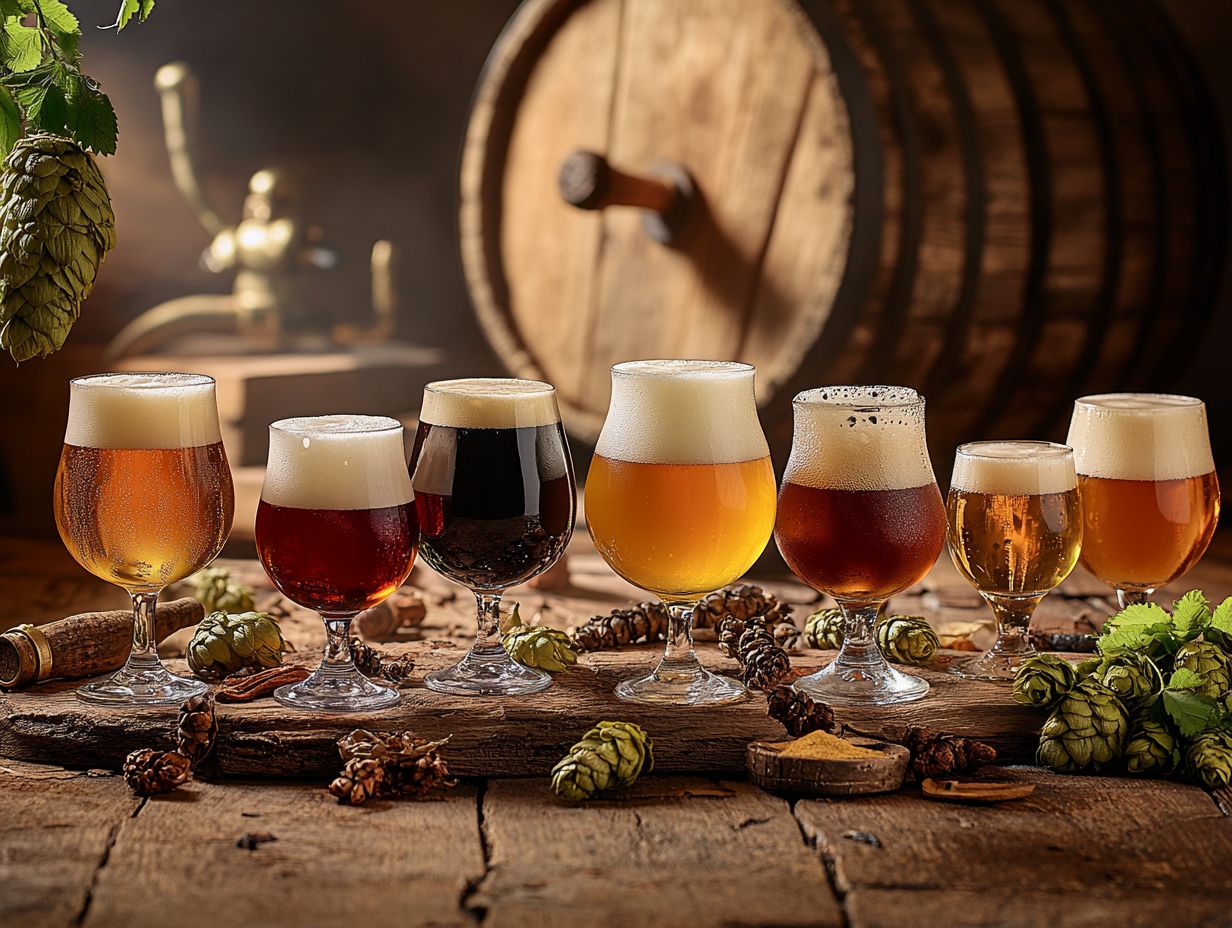
Sweet and malty flavors are the stars of several Belgian ale styles, particularly evident in Belgian Dubbel. This style presents a luxurious malt backbone, enriched with notes of caramel and dark fruits. The malt-driven profile is a key feature of many abbey ales.
To craft this enticing flavor profile, brewers use high-quality malt. They employ precise brewing techniques that emphasize sweetness, resulting in a smooth and satisfying drinking experience. Often, brewers select specialty malts that add layers of complexity, achieving a delightful balance between sweetness and warmth ideal for those who savor a fuller-bodied ale.
Belgian Quadrupel is another standout style, celebrated for its bold sweetness that delights every palate! It often showcases deeper caramel tones and subtle hints of dark chocolate. Similarly, Belgian Strong Ales exhibit complex sweetness and layered flavors. The brewing methods for these ales frequently involve a technique known as ‘mashing’, which deftly extracts sugars. Fermentation at warmer temperatures contributes fruity esters that enhance the overall profile, deeply rooted in traditional brewing practices.
Notable examples like Westmalle Dubbel and Rochefort 8 truly excel in highlighting these sweet, malty characteristics, making them sought-after choices for enthusiasts in search of richly flavored, nuanced beverages. These abbey ales demonstrate the brewing mastery of Belgian monks, offering a unique taste of Belgium. By looking into these brewing techniques, you can deepen your appreciation for the artistry behind these beloved styles.
Spicy and Complex
You ll find that Belgian ales are a treasure trove of spicy and complex flavors, especially in styles like Saison and Bi re de Garde. The fermentation process allows the yeast to unleash a stunning array of phenols, which contribute to the ale’s distinctive character. This complexity emerges from a mix of traditional ingredients and new brewing methods, creating a delightful interplay of spice, fruit, and earthiness.
Specific yeast strains can amplify these flavors, guiding you through a captivating tasting experience that evolves with every sip and showcases the remarkable creativity and craftsmanship of Belgian brewers. The use of Trappist and Abbey yeast strains adds another layer of history and culture to these brews.
The various yeast varieties, such as Brettanomyces a wild yeast that contributes unique flavors to the ale and different Saccharomyces strains, are key players in shaping the unique profiles of these ales. Take Dubbel and Tripel styles, for example; the fermentation process enhances flavors of caramel and dark fruit while weaving in layers of complexity through the presence of residual sugars.
The integration of spices, like classic coriander and some contemporary herbal innovations, adds depth to these beers. This invites you to savor their intricate nature and appreciate the skill involved in crafting each exquisite batch. These spiced ales often feature notes of citrus and other unique flavors, offering a versatile profile that is both traditional and innovative.
Explore your local craft beer selection and find a Belgian ale that intrigues your taste buds!
Fruity and Tart
Fruity and tart profiles are essential to several Belgian ales, particularly Lambics and Gueuze. These unique brews are celebrated for their distinctive fermentation processes, which use wild yeast and bacteria. You will often find bright, refreshing flavors of stone fruits and citrus, sometimes with a delightful tartness that dances on your palate.
The complexity of flavors in these styles is achieved through extended aging in barrels. This aging allows their character to develop, resulting in a vibrant and effervescent drinking experience that beer enthusiasts crave.
This captivating flavor profile primarily comes from the spontaneous fermentation, a natural brewing method using wild yeast, employed in many Belgian ales. The unique microflora in the environment plays a crucial role. The combination of Saccharomyces yeast with various wild yeasts like Brettanomyces, along with lactic acid bacteria, adds a layered depth of taste that is truly exceptional.
As the brewing process unfolds, the interaction among these microorganisms creates a symphony of fruity esters and lactic acidity. This further elevates your sensory experience. The higher ABV of many of these ales complements their complex flavors, adding warmth and depth to each sip.
The use of aged hops in these brewing methods imparts an earthy quality that balances the sharpness of the sour notes. This makes the final product not only complex but also remarkably enjoyable. You can truly taste this in styles like Flanders Red and Flanders Brown, where the interplay between hops and other ingredients creates a unique flavor profile.
Earthy and Funky
Earthy and funky flavors often dance in certain Belgian ales, especially those crafted with wild yeast strains and traditional fermentation methods like Saison and Farmhouse Ales. You might notice these characteristics vary from subtle earthy tones to bold, funky notes. They evoke a sense of terroir, reflecting the environment and ingredients used in the brewing process.
When barrel aging and mixed fermentation come into play, these qualities are enhanced, creating a complex and intriguing beer that appeals to adventurous palates craving something unique. This approach showcases the creativity and innovation that Belgian beer is celebrated for.
The interplay of ingredients like spelt, rye, or even aromatic hops adds to the rich tapestry of flavors woven into each batch. As you sip, consider the creative choices brewers make, such as secondary fermentation with fruit or herbs. These choices introduce layers of complexity that make each sip both refreshing and thought-provoking. This highlights the traditional yet innovative spirit of Belgian brewing culture.
The climate where these ales are produced also plays a vital role. Fluctuating temperatures during fermentation can open the door to diverse flavors, from tart and fruity to earthy and rustic. This invites you to explore a spectrum of taste experiences that go beyond the ordinary! The bottle-conditioned nature of many Belgian ales further adds to their unique appeal, offering a dynamic tasting journey.
The Rise of Bitter and Hoppy Flavors in Belgian Ales
Bitter and hoppy flavors are increasingly becoming a hallmark of Belgian ales, especially with the rise of Belgian IPAs that seamlessly blend traditional brewing techniques with the strong hop character characteristic of modern craft beers. You ll often find a delightful harmony between the bitterness of hops and the fruity compounds created during fermentation that add fruity flavors, creating a layered and inviting flavor experience.
Brewers are experimenting with a variety of hop types, leading to innovative profiles that beautifully showcase the best of both worlds the complexity of Belgian yeast and the strong bitterness of hops. This has given birth to hybrid styles like Belgian IPAs, which blend traditional Belgian brewing techniques with modern American craft beer influences.
Recent trends reveal brewers diving deeper into this interplay. Styles like Belgian Double IPAs and Belgian Witbiers showcase heavier hop profiles while still retaining the signature spice and fruit notes. This evolution in brewing reflects Belgium’s rich history of innovation and adaptation in beer production.
Notably, collaborations between traditional brewers and innovative craft breweries have birthed unique variations that push the boundaries of flavor. The inclusion of hops like Citra and Mosaic not only elevates bitterness but also enhances aroma, culminating in beers that cater to a wide range of palates, from seasoned aficionados to curious newcomers. This dynamic interaction is a testament to the enduring influence of Belgian beer styles on global brewing trends.
As a result, the evolution of hop utilization in Belgian ales has become a captivating topic among brewing circles, reflecting the ongoing creativity and evolution within this cherished category.
Food Pairings with Belgian Ales
Get ready for an exquisite culinary adventure! Pairing food with Belgian ales presents a journey where the diverse flavor profiles of these beers elevate a wide array of dishes.
The rich maltiness of a Belgian Dubbel complements robust cheeses beautifully, enhancing their flavors in a delightful dance. Meanwhile, the fruity and spicy notes of a Saison make it a stellar choice alongside grilled meats and seafood, adding depth to each bite.
Even desserts, especially those showcasing chocolate or fruit, can find a perfect partner in Belgian ales. This creates a well-rounded dining experience that celebrates the versatility of these brews.
Cheeses
Cheeses and Belgian ales create a symphony of flavors that elevate your tasting experience to new heights. The rich and diverse profiles of these beers enhance and complement the nuanced characteristics of various cheese styles.
For instance, the malty sweetness of a Belgian Dubbel pairs exquisitely with aged Gouda, while a sharp blue cheese can be beautifully balanced by the fruity esters of a Belgian Tripel. The carbonation and acidity in lighter ales like Witbier serve to cleanse your palate between bites of creamy cheeses, making it an incredibly versatile choice for your cheese pairings.
The earthy tones of a Saison harmonize wonderfully with herbed cheeses, emphasizing both the beer’s refreshing qualities and the cheese’s richness. A strong, dark Quadrupel is also capable of handling the intensity of mature cheddars, offering a delightful contrast to the cheese’s sharpness.
As a cheese lover and craft beer enthusiast, don t overlook the possibilities of pairing soft-ripened cheeses, like Brie, with the delicate floral notes of a Belgian Blonde Ale. This combination crafts a tasting experience that fascinates your senses and opens doors to new flavor landscapes. The sweetness and carbonation levels of these ales help to balance the richness and creaminess of the cheese, creating a harmonious culinary experience.
Try these pairings at your next gathering and elevate your tasting experience!
Meats
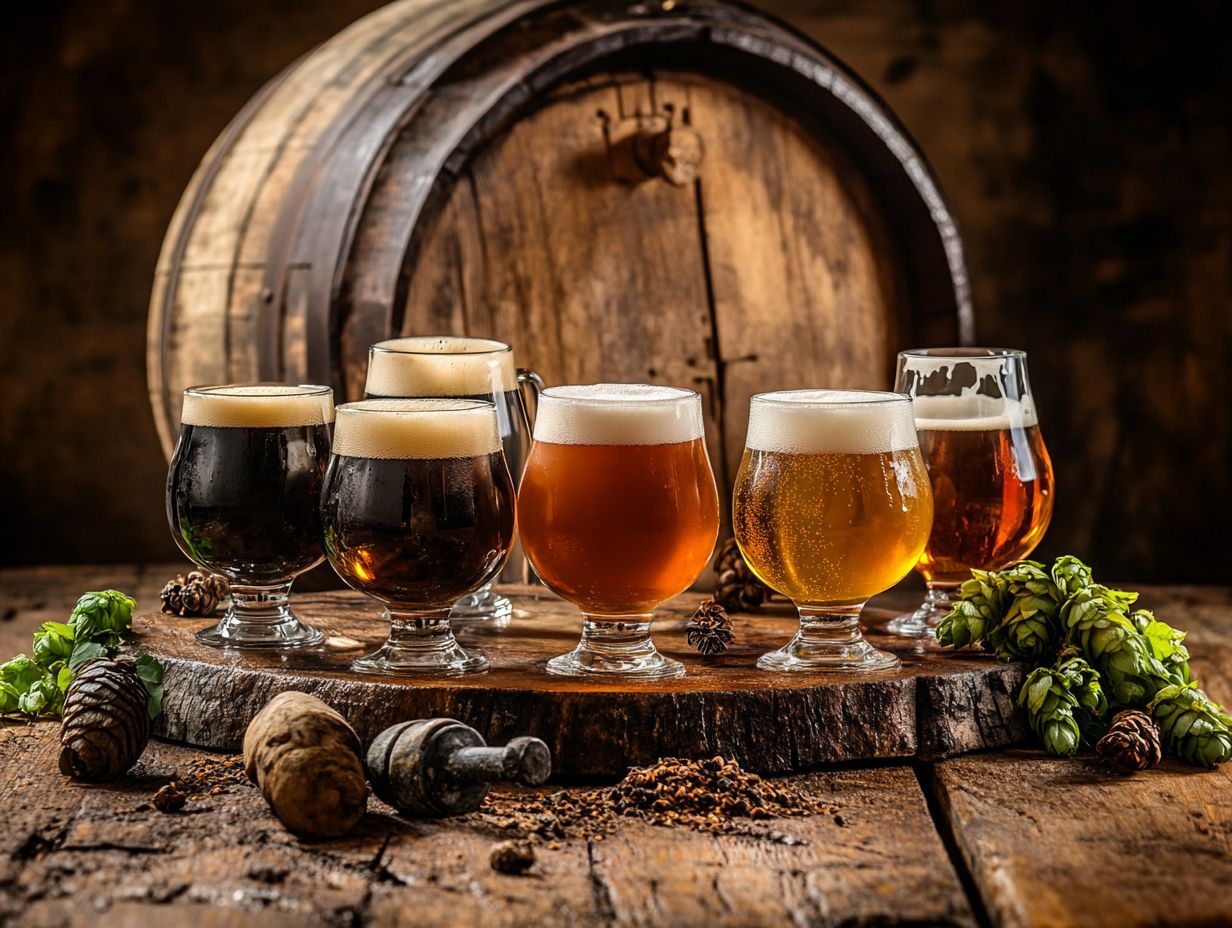
The art of pairing meats with Belgian ales opens up a world of culinary possibilities. The rich flavors of these beers beautifully enhance various meat dishes. Hearty meats like braised beef or roasted lamb find a delightful companion in the malty richness of a Belgian Dubbel. This combination creates a savory symphony that dances on your palate.
Meanwhile, the spicy and fruity characteristics of a Saison elevate grilled chicken or seafood. This pairing provides a refreshing contrast that maintains a harmonious balance with the dish’s flavors. Certain Belgian ales have a higher alcohol content, adding a warming element to your meal and enriching the overall culinary experience.
To delve deeper into this dynamic, imagine the deep, roasted notes of a Belgian Stout. This beer pairs excellently with smoked meats or rich barbecue dishes. Its dark malt profile adds an enticing depth to the overall experience. On the other hand, lighter fare such as pork or duck truly shines when matched with a Belgian Witbier. The zesty citrus and coriander notes cut through the richness while enhancing the dish’s natural flavors.
The versatility of Belgian beer styles offers endless pairing possibilities that cater to both traditional and adventurous palates. Embracing this thoughtful approach to meat and beer pairing enriches your dining experience. It invites a symphony of tastes that celebrates both the food and the ale, making each meal an extraordinary occasion. This method celebrates the rich history and culture of Belgian brewing, where food and beer have always been integral to social and culinary traditions.
Seafood
Seafood and Belgian ales create an exceptional pairing. These remarkable beers can elevate the delicate flavors of ocean fare. With a myriad of choices at your disposal, each Belgian ale stands ready to be the perfect companion to specific seafood dishes, enriching your overall flavor experience. The unique characteristics of Belgian beer, from its unfiltered nature to its bottle-conditioned complexity, make it an excellent match for the nuanced flavors of seafood.
Take, for instance, the creamy mouthfeel and herbal notes of a Tripel. It beautifully complements dishes such as lobster or creamy seafood risotto, balancing richness with harmonized flavors. Conversely, a crisp Pilsner, with its clean finish, pairs wonderfully with fried calamari or fish and chips. It cuts through the oiliness and refreshes your palate. Belgian beer, especially abbey ales and farmhouse ales, has distinct flavor profiles derived from unique brewing methods.
Each sip of beer highlights the intricate nuances of the seafood. This invites you on a dynamic and enjoyable dining adventure that engages all your senses. Belgian beer, with its complex flavors and rich history, offers a unique tasting experience.
Desserts
Pairing desserts with Belgian ales can elevate your culinary experience to new heights. The intricate flavors of these brews beautifully complement the sweetness and richness of various treats. Enjoying Belgian chocolate or waffles with a Dubbel or Quadrupel can be a delightful experience.
The interplay of flavors not only enhances your enjoyment of the dessert but also deepens your appreciation for the ale itself. It invites you to discover new and exciting taste profiles. For example, indulge in a rich chocolate dessert that brings forth the caramel and toffee notes in a Belgian Dubbel. Alternatively, savor a zesty lemon tart that harmonizes wonderfully with the citrus and floral notes of a Belgian Tripel.
Even lighter fare, such as panna cotta or creamy custards, can find a delightful balance with the dry, spicy finish of a Belgian Saison. Seasonal desserts, including summer fruit tarts or autumn spiced cakes, can also pair exceptionally well with various Belgian ales. By exploring these unique combinations, you can craft memorable dining experiences that celebrate the artistry of both dessert-making and brewing.
The local culture and traditional brewing methods of Belgium bring a rich history and depth to every sip.
Frequently Asked Questions
What are Belgian Ales and why are their flavor profiles unique?
Belgian Ales are a type of beer that originated in Belgium. They are known for their complex and unique flavor profiles due to specific ingredients and brewing techniques.
These techniques include the addition of spices and open fermentation. Abbey ales, particularly Trappist beers brewed by monks, are an important part of Belgium’s brewing heritage.
What are some common flavors found in Belgian Ales?
Common flavors found in Belgian Ales include fruity notes like banana, apple, and citrus. Spicy and herbal flavors arise from ingredients such as coriander, clove, and ginger.
How do different brewing methods affect the flavor profiles of Belgian Ales?
Open fermentation and specific yeast strains significantly affect the flavor profiles of Belgian Ales. This method allows more interaction with the environment, and different yeast strains produce varying levels of esters and phenols, resulting in diverse flavors.
What food pairings work well with Belgian Ales?
Belgian Ales are versatile when it comes to food pairings. They pair well with dishes that have a bit of spice or sweetness, such as Belgian frites, mussels, and rich stews.
How should Belgian Ales be served to fully appreciate their flavor profiles?
To fully appreciate their flavor profiles, Belgian Ales are best served in a tulip-shaped glass. This shape traps aromas and enhances the tasting experience.
Are there different styles of Belgian Ales and how do they differ in flavor profiles?
Belgian Ales have several different styles, including Dubbel, Tripel, and Saison. Each has a unique flavor profile; some are fruity and spicy, while others lean more toward malt or hops.
Dive into the world of Belgian Ales to discover your favorite flavor!

